
Politics
17:05, 13-Oct-2018
State of the race: Democrats trend up, Trump approval drops
Updated
16:29, 16-Oct-2018
By John Goodrich
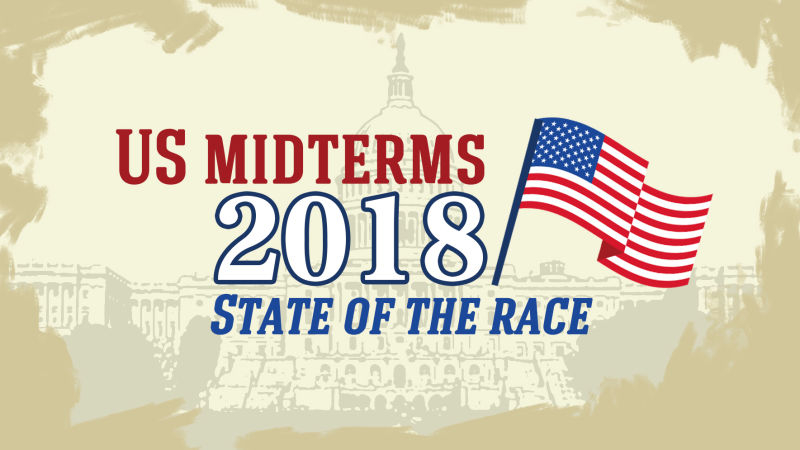
In the week in which pop superstar Taylor Swift made a surprise intervention into politics and Brett Kavanaugh was confirmed as a Supreme Court justice, three key indicators have trended in favor of the Democrats ahead of the November 6 US midterm elections.
Last week: US midterms 2018, one month out
What's happened in the past week?
As well as the Kavanaugh confirmation and Swift's Democratic endorsements, Hurricane Michael hit Florida, Nikki Haley resigned as US ambassador to the United Nations (UN) and Donald Trump's Oval Office meeting with rapper Kanye West drew a mixed reaction.
The Kavanaugh news appears to have enthused Republican voters in red states like Tennessee, though the latest polling suggests Democrats have benefited more nationwide.
Swift's intervention, urging support for two Democrats in Tennessee, made big news and was credited with voter registration in the state surging by 65,000 in just 24 hours.
However, a new New York Times/Sienna College poll on Friday showed Republican Marsha Blackburn had extended her lead over Democrat Phil Bredesen in the Senate race to 14 points. They were level-pegging before the Kavanaugh hearings.
The responses of politicians to the devastation wrecked by hurricane Michael in Florida could be significant, with competitive senate and gubernatorial races.
Indicators
Generic ballot
The Democrats have extended their lead over the Republicans in the generic congressional ballot, an indicator averaging how people say they would vote in an election irrelevant of district or state.
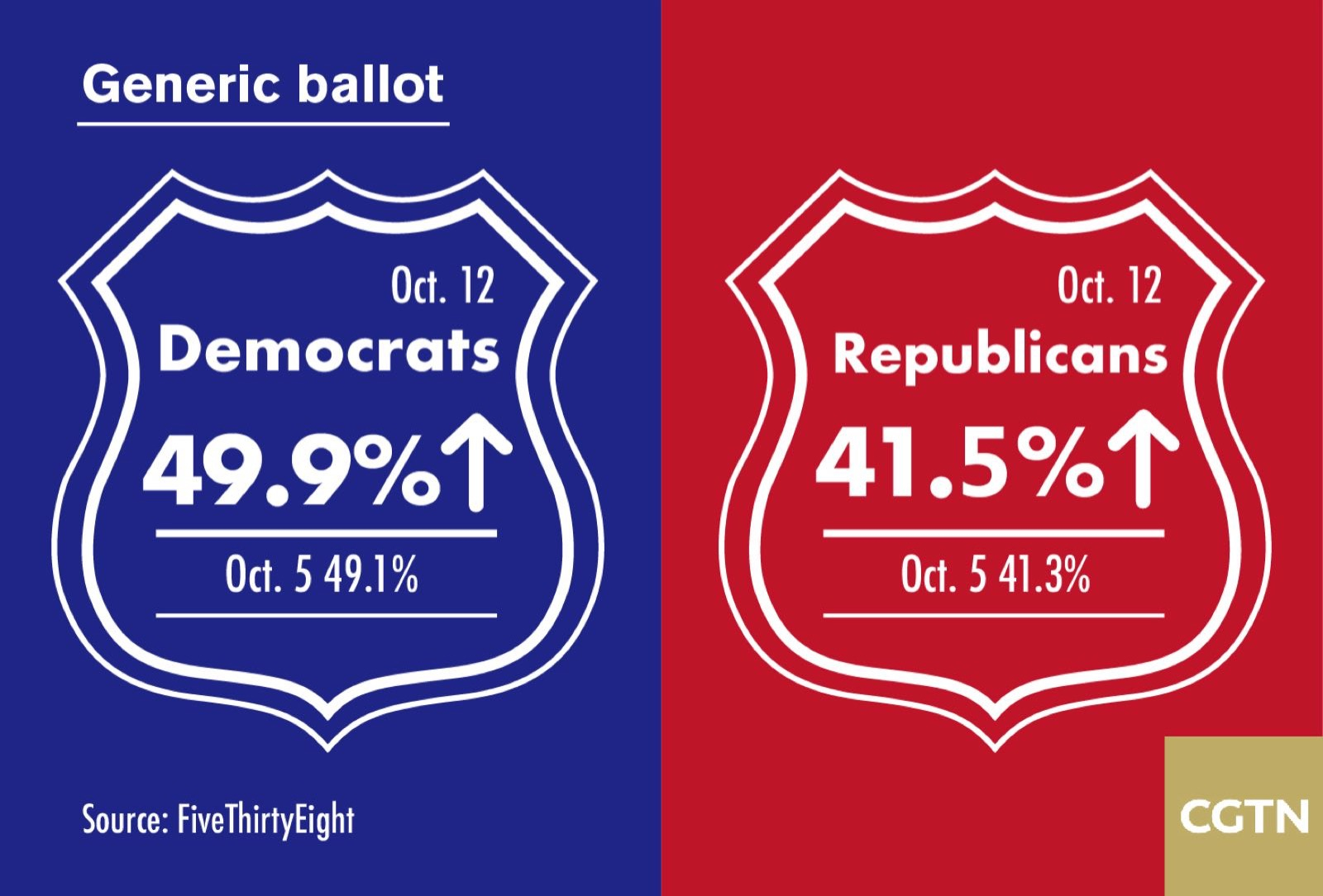
The latest calculation from FiveThirtyEight puts the Democrats 8.4 points -- a weekly increase of 0.6 percentage points -- ahead of the Republicans with 49.9 to 41.5 percent.
The percentages for both parties increased --Democrats by 0.8 percent and Republicans 0.2 percent -- indicating more voters are making up their minds as the election approaches, as well as a clear trend to the Democrats.
CNBC analysts say a 12-point gap would probably be required for a "blue wave" -- Democratic victories in both houses of Congress -- while a six-to seven-point margin would probably be needed for the Democrats to take just the House.
Indicator favors: DEMOCRATS
Presidential approval
Donald Trump isn't on the ballot on November 6, but midterm elections are a referendum on the sitting president – 60 percent of people see their vote as an expression of opposition or support towards the man in the White House, according to a September Pew Research Center poll.
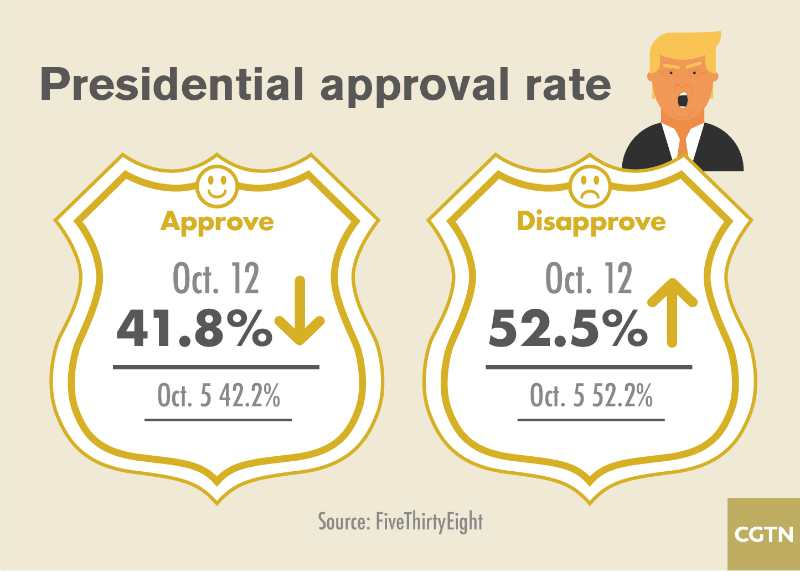
A president's party nearly always suffers a net loss in midterm elections -- Gallup's polling history shows that presidents with approval ratings of below 50 percent have seen their party lose an average of 37 House seats in midterms.
Trump's approval rating of 41.8 percent on October 12, according to a FiveThirtyEight calculation of multiple polls, was down 0.4 percentage points a week earlier.
Indicator favors: DEMOCRATS
Voter enthusiasm
In the 2014 midterms only 35.9 percent of eligible adults voted, but the September Pew survey suggests enthusiasm among registered midterm voters is at its highest point in more than two decades.
Sixty-seven percent of Democrats and 59 percent of Republicans said they were more enthusiastic than usual about the voting in November.
The recent saga over the confirmation of Kavanaugh has enthused voters from both sides of the divide, but a new POLITICO/Morning Consult poll suggests country-wide Democrats have benefited the most.
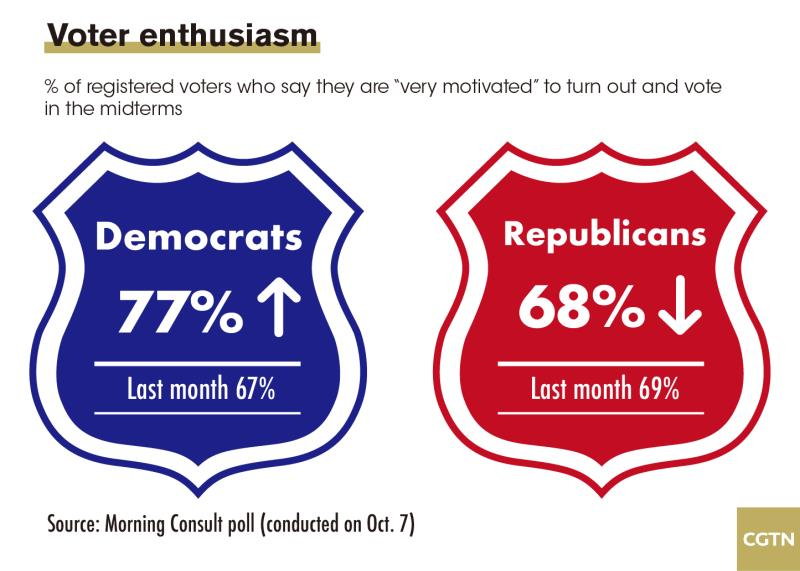
The poll shows a majority of voters, 46 to 40 percent, think the Senate was wrong to confirm Kavanaugh as a Supreme Court justice and that 77 percent of Democrats are "very motivated" to turn out to vote (up 10 points from a month earlier) against 68 percent for the Republicans (down one point).
Indicator favors: DEMOCRATS
Races
House of Representatives
All 435 seats are up for election in the House, where the Republicans currently hold a 235-193 majority (seven seats are vacant). To take control of the House, the Democrats need a net gain of 23 seats.
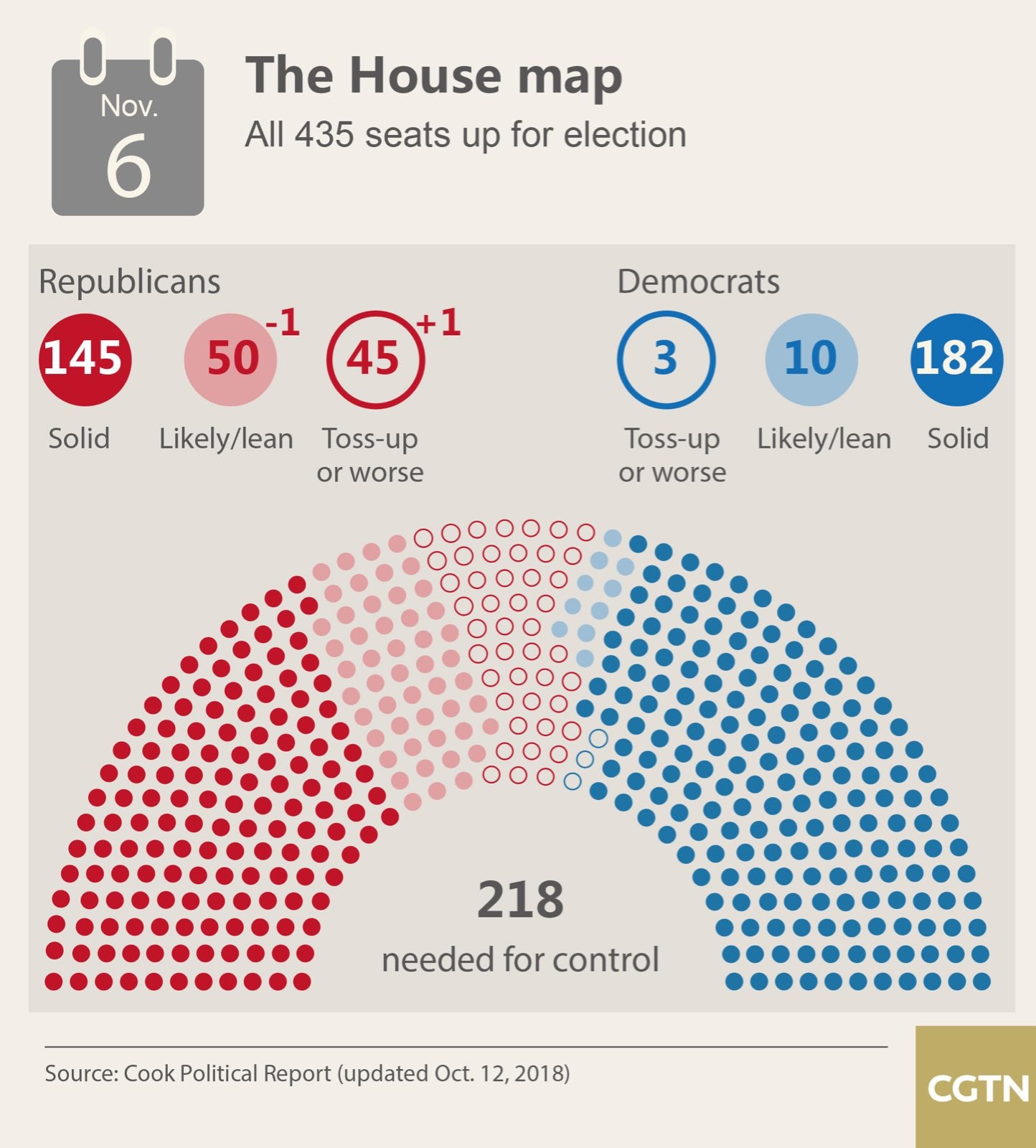
The latest update from The Cook Political Report moves an Illinois Republican House race from leaning Republican to a toss-up, meaning 45 Republican-held seats are now toss-ups and a further 50 are competitive. Only three Democratic seats are toss-ups and 10 more are considered competitive.
FiveThirtyEight's latest forecast gives the Democrats a 79.1 percent (up from 73.9 percent a week ago) chance of winning control, and the Republicans a 20.9 percent (down from 26.1 percent) chance of retaining a majority.
Current trends suggest: DEMOCRATIC MAJORITY
Senate
Thirty-five seats are up for grabs in the Senate, where the Republicans hold a slim 51-49 advantage. The Democrats only need two seats to take control of the chamber but the Republicans are in the box seat – they are defending nine seats and attacking 26.
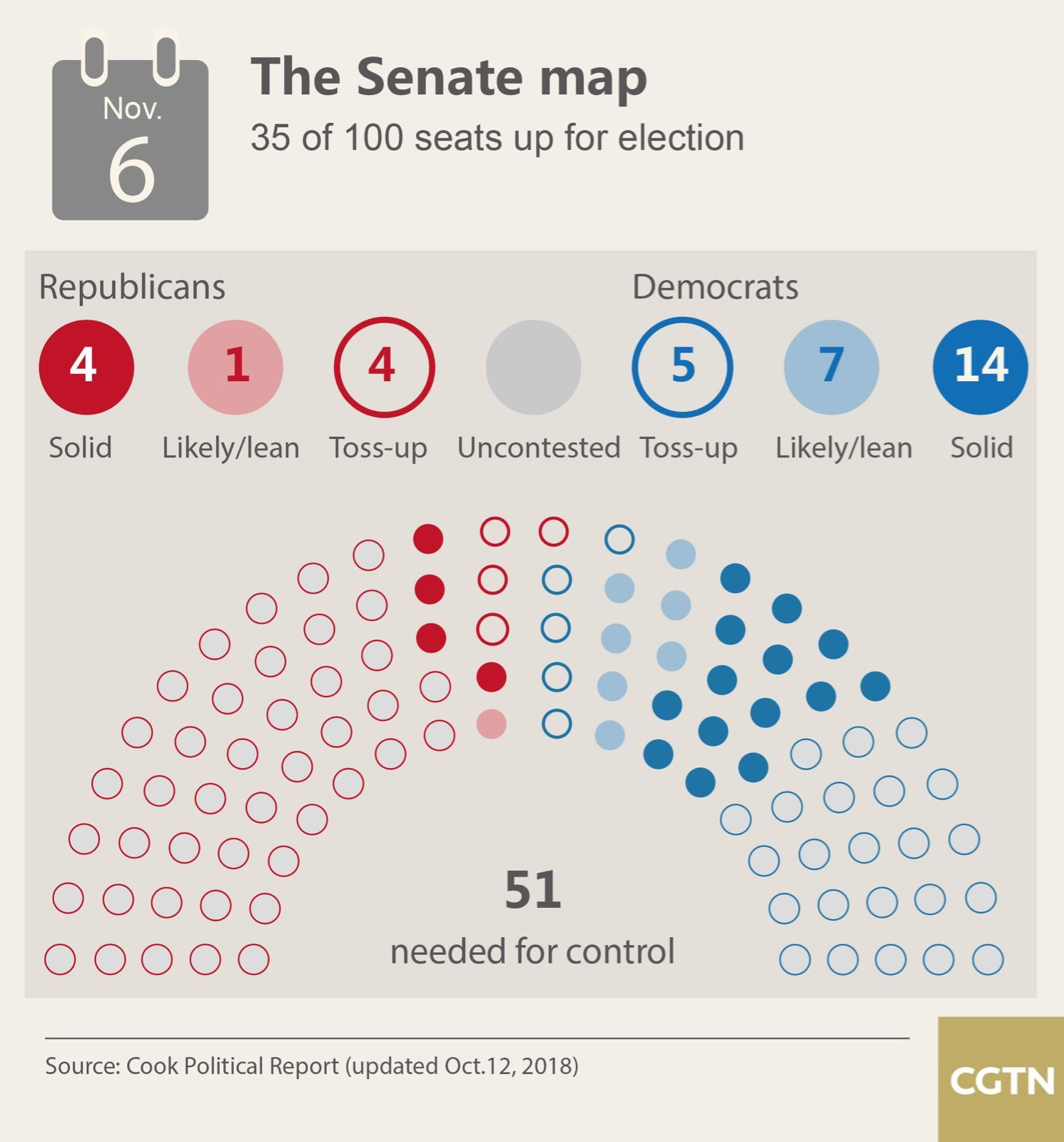
The latest update from The Cook Political Report shows no change from last week. Four of the nine Republican-held seats are toss-ups, and five of the 26 Democrat-held seats fall into the same category.
FiveThirtyEight's latest forecast gives the Democrats an 18.7 percent (down from 22.0 percent a week ago) chance of winning control, and the Republicans an 81.3 percent (up from 78.0 percent) chance of retaining a majority.
Current trends suggest: REPUBLICAN MAJORITY
Gubernatorial
Thirty-six state governor's mansions are being contested in 2018, 26 of which are currently held by Republicans, nine by Democrats and one by an independent.
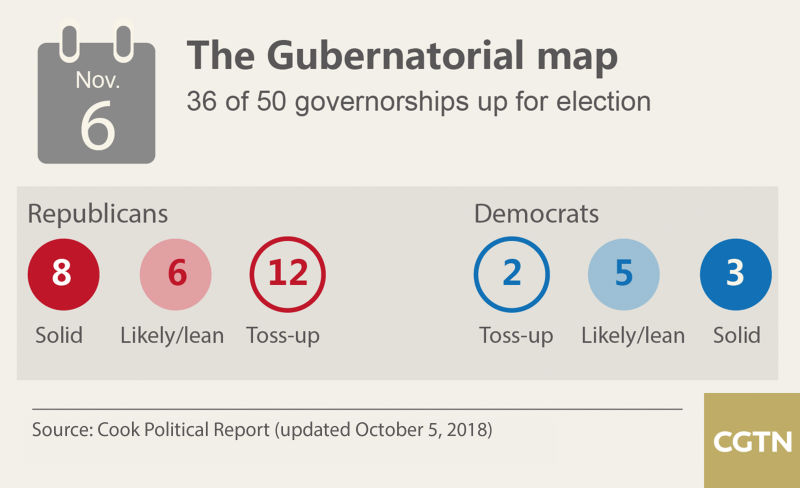
The Republicans currently hold 33 governorships, so 2018 is an opportunity for the Democrats, who are defending two toss-up governorships to the Republicans' 12 according to The Cook Political Report, to hit back.
(Graphics by Zhao Hong, Li Wenyi, Yu Peng)

SITEMAP
Copyright © 2018 CGTN. Beijing ICP prepared NO.16065310-3
Copyright © 2018 CGTN. Beijing ICP prepared NO.16065310-3